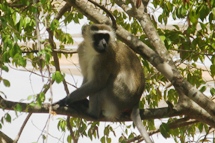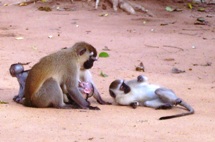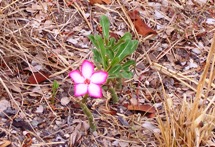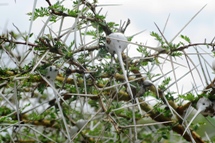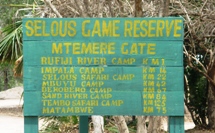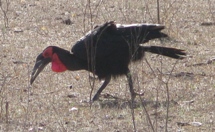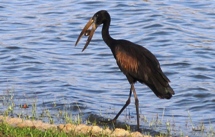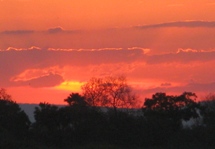Tanzania & Zanzibar: Day Eight: Rufiji River Camp
On leaving our tent for breakfast the following morning we saw numerous vervet monkeys playing in the trees around the tent (![]() ), together with tree squirrels on the bank in front of the tent. Interestingly there was a pile of elephant droppings on the path behind the tent, although we hadn’t been aware of its presence (the tents are rather close together, and any such noise may have been drowned out by the noise of snoring coming from the next tent!).
), together with tree squirrels on the bank in front of the tent. Interestingly there was a pile of elephant droppings on the path behind the tent, although we hadn’t been aware of its presence (the tents are rather close together, and any such noise may have been drowned out by the noise of snoring coming from the next tent!).
There were then further vervets enjoying themselves around the breakfast area (![]() ).
).
At around 8.00 a.m. we went out on a game walk, accompanied by a guide and armed scout. Unlike such walks in Zambia, we didn’t see an awful lot of game, but instead were fascinated by the guide’s wealth of knowledge about the trees and plants that we passed.
For example, the 'Desert Rose' flower shown opposite (![]() ), said to be similar to the oleander, but somewhat poisonous, and the whistling thorn acacia tree (
), said to be similar to the oleander, but somewhat poisonous, and the whistling thorn acacia tree (![]() ), opposite. Its bulbous thorns are naturally hollow and occupied by any one of several symbiotic ant species, and into which they have made entry/exit holes. When the wind blows over these they create a whistling noise.
), opposite. Its bulbous thorns are naturally hollow and occupied by any one of several symbiotic ant species, and into which they have made entry/exit holes. When the wind blows over these they create a whistling noise.
If a herbivore, such as a giraffe, tries to eat its leaves they exude noxious tannins in order to discourage them, and this is picked up by other leaves nearby, which react similarly. However the giraffes have also developed the stratagem of beginning to eat downwind, to avoid their presence being notified in this way. Fascinating!
Similarly interesting was the 'crocodile bark tree' (![]() ), below. We bet you didn't spot the tree frog (
), below. We bet you didn't spot the tree frog (![]() ), below, situated right in the middle of the picture, about one third up. Neither did we, until shown it.
), below, situated right in the middle of the picture, about one third up. Neither did we, until shown it.
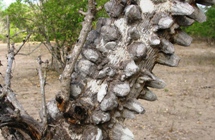
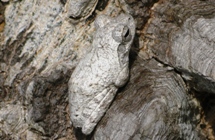
On our way back we passed by the Reserve's Mtemere Gate (![]() ), opposite, close to which were the remains of the old steam engine shown below (
), opposite, close to which were the remains of the old steam engine shown below (![]() ), a further relic of the First World War (
), a further relic of the First World War (![]() ).
).
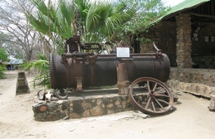
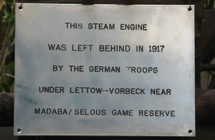
After lunch, and a siesta, we went on an afternoon game drive, accompanied by an American girl who sat in the front next to the driver. Perhaps unsurprisingly he seemed to forget that we were in the back and talked exclusively to her most of the time and, since we couldn’t really hear what he was saying, it wasn’t all that great an experience. However we saw quite a lot of game, including giraffe (![]() ) and a kudu (
) and a kudu (![]() ), below.
), below.
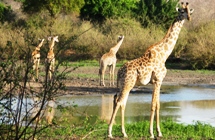
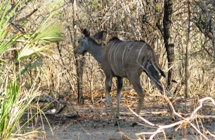
plus crocodile, lots of ellies, a ground hornbill (![]() ), opposite, above, and, best of all, an open billed stork (
), opposite, above, and, best of all, an open billed stork (![]() ) – very much justifying its name, as it helped itself to a mollusc. Finally yet another spectacular sunset (
) – very much justifying its name, as it helped itself to a mollusc. Finally yet another spectacular sunset (![]() ).
).
| Back to previous page (Day 7) | Forward to next page (Day 9) |
